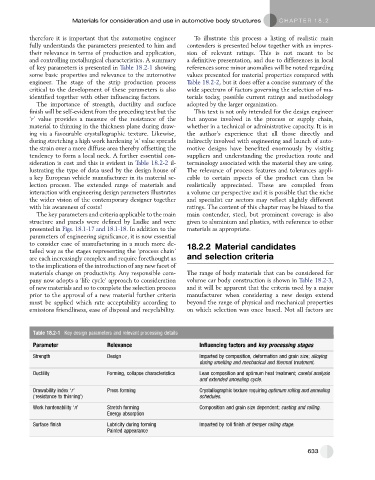Page 622 - Automotive Engineering Powertrain Chassis System and Vehicle Body
P. 622
Materials for consideration and use in automotive body structures C HAPTER 18.2
therefore it is important that the automotive engineer To illustrate this process a listing of realistic main
fully understands the parameters presented to him and contenders is presented below together with an impres-
their relevance in terms of production and application, sion of relevant ratings. This is not meant to be
and controlling metallurgical characteristics. A summary a definitive presentation, and due to differences in local
of key parameters is presented in Table 18.2-1 showing references some minor anomalies will be noted regarding
some basic properties and relevance to the automotive values presented for material properties compared with
engineer. The stage of the strip production process Table 18.2-2, but it does offer a concise summary of the
critical to the development of these parameters is also wide spectrum of factors governing the selection of ma-
identified together with other influencing factors. terials today, possible current ratings and methodology
The importance of strength, ductility and surface adopted by the larger organization.
finish will be self-evident from the preceding text but the This text is not only intended for the design engineer
‘r’ value provides a measure of the resistance of the but anyone involved in the process or supply chain,
material to thinning in the thickness plane during draw- whether in a technical or administrative capacity. It is in
ing via a favourable crystallographic texture. Likewise, the author’s experience that all those directly and
during stretching a high work hardening ‘n’ value spreads indirectly involved with engineering and launch of auto-
the strain over a more diffuse area thereby offsetting the motive designs have benefited enormously by visiting
tendency to form a local neck. A further essential con- suppliers and understanding the production route and
sideration is cost and this is evident in Table 18.2-2 il- terminology associated with the material they are using.
lustrating the type of data used by the design house of The relevance of process features and tolerances appli-
a key European vehicle manufacturer in its material se- cable to certain aspects of the product can then be
lection process. The extended range of materials and realistically appreciated. These are compiled from
interaction with engineering design parameters illustrates a volume car perspective and it is possible that the niche
the wider vision of the contemporary designer together and specialist car sectors may reflect slightly different
with his awareness of costs! ratings. The content of this chapter may be biased to the
The key parameters and criteria applicable to the main main contender, steel, but prominent coverage is also
structure and panels were defined by Ludke and were given to aluminium and plastics, with reference to other
presented in Figs. 18.1-17 and 18.1-18. In addition to the materials as appropriate.
parameters of engineering significance, it is now essential
to consider ease of manufacturing in a much more de- 18.2.2 Material candidates
tailed way as the stages representing the ‘process chain’
are each increasingly complex and require forethought as and selection criteria
to the implications of the introduction of any new facet of
materials change on productivity. Any responsible com- The range of body materials that can be considered for
pany now adopts a ‘life cycle’ approach to consideration volume car body construction is shown in Table 18.2-3,
of new materials and so to complete the selection process and it will be apparent that the criteria used by a major
prior to the approval of a new material further criteria manufacturer when considering a new design extend
must be applied which rate acceptability according to beyond the range of physical and mechanical properties
emissions friendliness, ease of disposal and recyclability. on which selection was once based. Not all factors are
Table 18.2-1 Key design parameters and relevant processing details
Parameter Relevance Influencing factors and key processing stages
Strength Design Imparted by composition, deformation and grain size; alloying
during smelting and mechanical and thermal treatment.
Ductility Forming, collapse characteristics Lean composition and optimum heat treatment; careful analysis
and extended annealing cycle.
Drawability index ‘r’ Press forming Crystallographic texture requiring optimum rolling and annealing
(‘resistance to thinning’) schedules.
Work hardenability ‘n’ Stretch forming Composition and grain size dependent; casting and rolling.
Energy absorption
Surface finish Lubricity during forming Imparted by roll finish at temper rolling stage.
Painted appearance
633

